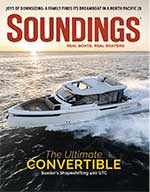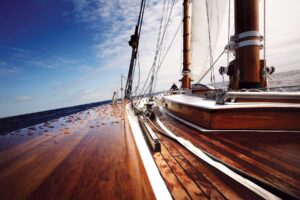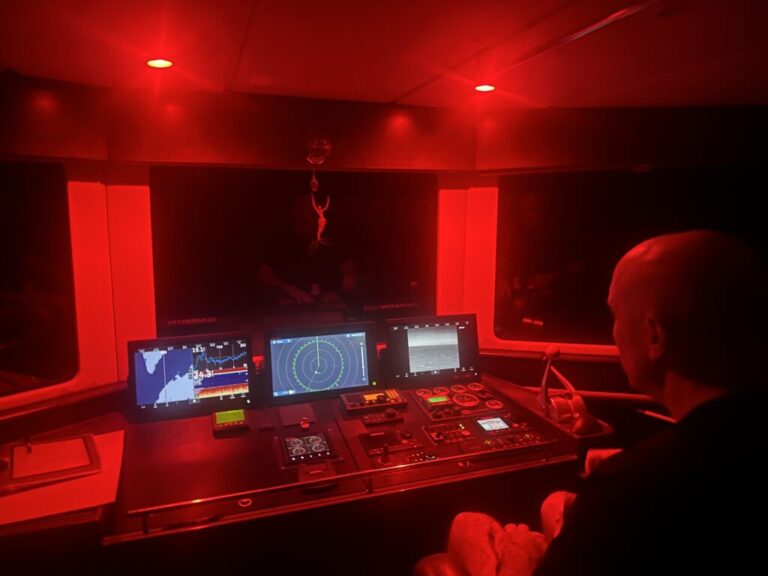Rockland rocks. Nearly every summer weekend, festivals — from blues or boats to art or lobster — draw tens of thousands to this former blue-collar city on Penobscot Bay, Maine’s prime cruising grounds.
Rockland rocks. Nearly every summer weekend, festivals — from blues or boats to art or lobster — draw tens of thousands to this former blue-collar city on Penobscot Bay, Maine’s prime cruising grounds.
This county seat of 8,000 has three anchorages and 400-plus moorings in its 4-square-mile harbor. New marinas have sprung up, old ones spruced up, and all welcome cruisers to Rockland, an unpretentious, exciting port.
Ashore, the venerable FarnsworthArt Museum and the new MaineLighthouseMuseum (said to house the largest collection of lighthouse artifacts in the country) are world-class. Some 18 art galleries, dozens of boutiques, tony restaurants and service businesses occupy Main Street’s imposing 19th-century brick buildings — quite a change from the days when 20 storefronts stood empty, and pungent fish rendering plants lined the harbor.
“This is the real Maine, the way Maine life should be,” he says.
“Rockland’s one of my favorite ports,” says Rick Maxwell of Augusta, Maine, who cruises with his wife, Carol, on their Sea Ray 268 Sundowner, Joyful Sunshine. “It’s easy in, easy out for boaters, with good restaurants and eclectic shops. We found a half-dozen new eateries and shops [last] year, and new places are opening all the time. It’s not the same village as five years ago.”
A car isn’t a necessity when tying up for a visit. Rockland Public Landing (municipal marina) is in HarborPark, right downtown, and the private marinas also are only steps from Main Street. Harbormaster Ed Glaser, 54, former owner and captain of the windjammer Isaac Evans, is committed to serving boaters and maintaining Rockland’s three designated anchorages so that boating doesn’t become just a “rich man’s sport.”
“We want boaters to come to Rockland, so we must have a place for them,” he says. The northern anchorage, just inside the Rockland Breakwater, is the most protected.
You can dinghy to the city’s float or take a water taxi ashore. Before hitting the shops, however, you’ll likely want to pause at one of the harborfront benches — not only to view your boat but to take in some of the maritime hustle and bustle. Rockland’s sightseeing boats, 15 passenger schooners, ferries to Penobscot Bay islands, lobster boats, fishing and Coast Guard vessels, sailboat races and sailing classes are all part of the action.
The diorama in the GatewayVisitorCenter recalls Rockland in 1907, when shipyards turned out wooden vessels, fishing boats filled the harbor, passenger steamers from Boston docked, and coasting schooners loaded lumber, fish and lime for East Coast cities. The MaineLighthouseMuseum, also in the visitor’s center, is a must-see. (See accompanying story.)
From the center, you can take a narrated trolley tour or walk the 5.5-mile Harbor Trail, which marks historic sites along what many call the best waterfront walk in Maine. Stroll south to SnowMarinePark (site of the Snow Shipyard from 1860 through World War II), past credit card giant MBNA’s former complex, a sandy swimming beach, and HurricaneIslandOutwardBoundSchool. Or head 1.5 miles north, through downtown, past the state ferry terminal and the only remaining lime-burning kiln. Just beyond is the Atlantic Challenge Foundation/Rockland Apprenticeshop, where young people build wooden vessels using traditional methods.
The Harbor Trail continues a mile or so around the harbor to MarieReedPark, Samoset Resort (and golf course), and the Rockland Breakwater. From 1888 to 1895, nearly 700,000 tons of granite were barged from VinalhavenIsland to construct the 4,346-foot breakwater. It’s worth the walk out to the 1902 lighthouse, especially during boat races. The keeper’s house is open periodically. (You also can dinghy to the lighthouse floating dock or take the boat tour.)
The FarnsworthArt Museum — www.farnsworthmuseum.org — which focuses on Maine’s influence on American art, is the reason many consider Rockland a fine-arts destination. “Paintings of Maine after the War of 1812 helped transform the state from a largely undeveloped wilderness into a popular tourist destination,” says David Stucky, museum marketing director.
Founded in 1948 by the estate of lime heiress Lucy Farnsworth, the museum is of “higher quality than expected” for a regional museum, Stucky says. The Farnsworth family had no art collection. Curators purchased the core collection — works by Winslow Homer, George Bellows, Fitz Henry Lane, Frank Benson, the Wyeths (illustrator N.C., and painters Andrew and Jamie), Rockwell Kent, sculptor Louise Nevelson, and other famous artists with Maine ties — when they were affordable. The collection now comprises more than 7,000 works in many media.
Permanent displays of Maine art from the 18th century to the present range from portraits of bewigged gentlemen to a gallery of contemporary works. The museum’s renowned collection from three generations of Wyeths fills the former MethodistChurch. This summer the 5-acre, 12-gallery downtown Farnsworth complex features works by Jamie Wyeth — honoring his 60th birthday — and an exhibit of Homer’s paintings.
Adjacent to the museum is the Farnsworth Homestead, built by William Farnsworth in 1849 and home of his daughter, Lucy, until her death in 1937. Except for a coal furnace added in 1900, the house remains as it was in 1876: an untouched monument to the architecture and lifestyle of wealthy Victorians. The Farnsworth museum also encompasses the Olson House in Cushing (you’ll need transportation), made famous in Andrew Wyeth’s painting “Christina’s World.”
Stroll the shady streets west of the Farnsworth, and you’ll pass the prestigious Greek Revival, Italianate and Mansard mansions of Rockland’s 19th-century elite. Less than 100 years after its founding as “Shore Village” in 1765, Rockland prospered from the shipping industry, its 18 shipyards and 18 lime-burning kilns. The 250-foot clipper ship Red Jacket, built here in the 1850s, still holds speed records.
When the lime industry died, heavy industry, fishing docks and processing plants took over the harborfront. They’re gone, save for a shipyard on each end of the harbor and commercial fishing businesses on the downtown peninsula marked by the Coast Guard station.
“The last fish-processing plant closed [some 10 years ago],” says the chamber of commerce’s Hastings. “Changing the harbor changed the city. Now this is a real happening place — festivals, evening entertainment and 18 galleries on the Wednesday night Gallery Walk.” Locals say Rockland’s lobster landings make it the “Lobster Capital of Maine.”
The Maxwells, the cruisers from Augusta, enjoy discovering new shops — The Wine Seller, que pasa on main, Liberty Tree Antiques and others — and frequenting old favorites — Hamilton Marine, Second Read Books & Coffee, and Bookyard Books and Archipelago, which features fine arts and crafts by more than 200 Mainers. (The shop is part of the Island Institute, a non-profit organization serving island and coastal communities.)
You need walk no farther than the dock for a place to eat. During the North Atlantic Blues Festival, Maine Lobster Festival, Maine Boats, Homes & Harbors Show, and Harbor Fest weekends, vendors in HarborPark serve food for every taste, including 22,000 pounds of lobster during Lobster Festival. Funky nautical Conti’s Restaurant and barebones takeouts in the park, nearby LandingsMarinaRestaurant and Time Out Pub overlook the harbor. Dozens more restaurants, several with shady outdoor tables, line Main Street. Some are trendy (Atlantic Baking Company, WaterWorks BrewPub), some gourmet (Café Miranda, Almafi and Primo), some ethnic. Mealtime lines are common at down-home favorites Rockland Café, Wasses’ Hot Dogs and The Brown Bag. Or take a busman’s holiday on a dinner cruise.
Activity extends into the night. Eighteen art galleries are open for Wednesday-evening Gallery Walks. Several restaurants and pubs feature live entertainment, especially on festival weekends, and LincolnStreetCenter for Arts and Education presents summer concerts and exhibitions. Main Street’s restored 1923 Strand Theater opened last summer after a $16 million restoration. Patrons sit in plush red velvet seats beneath the pressed-tin ceiling to view nightly concerts, performances or classic, foreign and avant-garde films.
City officials are working to bring in more cruise ships and to connect Rockland by ferry with Bar Harbor and by train with L.L. Bean and Portland. (You can ride as far as Brunswick and back.)
“Rockland’s a fabulous destination,” says Maxwell. “Each year the shops and restaurants are better and better.”










